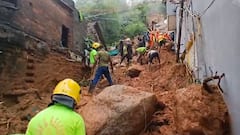Why India Saw An Increase In Earthquakes In 2023? Govt Replies In Parliament
Parliament Winter Session: India registered 124 earthquakes between January and November as compared to 65 in 2022, Earth Sciences Minister Kiren Rijiju told Lok Sabha.

The year 2023 saw an increase in earthquake activity, with India registering 124 temblors between January and November as compared to 65 in 2022, Earth Sciences Minister Kiren Rijiju informed Parliament. In a written reply in Lok Sabha, Rijiju attributed the increase in quakes to the activation of the Almora fault in western Nepal.
The government said the activation in the Almora fault triggered significant earthquake incidents on January 24 (5.8 magnitude), October 3 (6.2 magnitude) and November 3 (6.4 magnitude).
"These mainshocks, accompanied by subsequent aftershocks, have led to an increased frequency of earthquakes in the year 2023. However, the background seismicity remained unchanged during this period," the Centre's reply in Lok Sabha said.

As per the reply, most earthquakes in 2023 (97) were between magnitude 3.0 to 3.9. There were 21 earthquakes between magnitude 4.0 to 4.9 and 4 quakes between 5.0 to 5.9 magnitude. Two earthquakes were recorded having a magnitude of 6.0-6.9.
Northern India and Nepal are vulnerable to earthquakes and fluctuations in seismic activity as they are situated near the active faults of the Himalayan region." Nepal and the neighbouring northern part of India are highly seismically active areas prone to frequent earthquakes due to collision tectonics, where the Indian plate subducts beneath the Eurasian Plate," the Centre said.
The Almora fault is a high-angle tectonic plane separating the Garhwal group of inner lesser Himalaya in the north from Jaunsar and Dudatoli groups of outer lesser Himalayas in the south.
On measures the government has taken to insulate the people and buildings from potential damages due to quakes, Rijiju said the Bureau of Indian Standards (BIS) had published a Seismic Zoning map, ranging from Zone II to V, that had guidelines for implementing essential engineering codes and practices to construct earthquake-resistant buildings. He also said that mock drills and awareness programs were being held regularly by the National Disaster Management Authority.
"The National Disaster Management Authority (NDMA) has been responsible agency for various precautionary measures such as earthquake drills, awareness programs, earthquake management, etc., to enhance preparedness and response to earthquake-related incidents," the statement further said.
Last month, strong tremors were felt in Delhi and surrounding states in north India after a powerful 6.4 magnitude earthquake, the most severe since 2015, hit Nepal. The quake left over 150 dead and caused extensive damage to hundreds of houses in the Himalayan country.
Trending News
Top Headlines






































